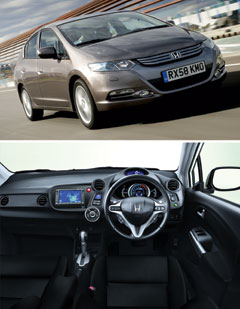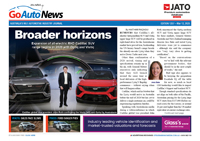Make / Model Search
Future models - Honda - CR-ZHonda reveals EV, plug-in hybrid plansPowering up: Honda has switched on plans for more hybrids and EVs, beyond products such as the 2011 CR-Z hybrid. Electric car and plug-in hybrid due in 2012 as Honda sets out eco-car strategy22 Jul 2010 By TERRY MARTIN HONDA has revealed plans to introduce a raft of new eco models and green technologies, including a full-electric vehicle and a new plug-in hybrid system for medium and large-sized vehicles, all due to go on sale in Japan and the US in 2012. The Japanese manufacturer has also reaffirmed its commitment to broaden its current IMA petrol-electric hybrid system beyond the soon-to-be-released Insight and the 2011 CR-Z to “multiple” models, including the Jazz light car, and will equip its next-generation Civic hybrid due late next year with a lithium-ion battery, replacing the current nickel-metal hydride unit. Furthermore, Honda will introduce an all-new small diesel engine in Europe in 2012, and will begin renewing its entire petrol engine and transmission line-up from 2012 to make further inroads into fuel consumption. Australia is certain to benefit from the Civic hybrid changes, which will follow the launch of the Insight late this year – a car Honda Australia has confirmed will take on a suspension upgrade announced overnight – and the CR-Z, which is due to be released in the second half of 2011. The Australian division has also told GoAuto that all model plans announced by Honda Motor Co president and CEO Takanobu Ito in his annual mid-year speech in Tokyo this week were either under consideration or of interest pending confirmation of their availability in this market. “Plug-in hybrids, if they’re available for this market, will certainly be given our consideration,” said spokesman Mark Higgins. “They’ve got to satisfy the Japanese and US markets first, that’s primarily where those vehicles are being developed for. “But if that technology is viable in other parts of the world, including Australia, then they’ll certainly be given our consideration.  Left: Honda Insight. Left: Honda Insight.“We’d certainly welcome the opportunity to explore all sorts of avenues as far as different propulsion systems are concerned.” Mr Higgins said there was interest is securing the still-to-be-revealed battery electric vehicle, which would provide Honda with a competitor for the Nissan Leaf and Mitsubishi i-MiEV in Australia. Honda plans to leverage technologies from its fuel-cell EV development program for the production battery EV, with public trials starting later this year ahead of series production in 2012. “We’ll have a look at that and see where the market is going in respect to that technology, and make some decisions from there,” Mr Higgins said. “But certainly, that vehicle is under consideration for Australia.” Mr Higgins also confirmed that a Jazz hybrid would be considered once the Insight, CR-Z and next-generation Civic hybrid were on sale in Australia, when the company could assess market demand “and see what the opportunities are for a light hybrid”. Honda describes the hybrid system’s new lithium-ion battery “as high-output and compact” and has confirmed that it will be supplied by Blue Energy, a joint-venture company between Honda and GS Yuasa. Production of the new battery will begin later this year. Honda has also committed to a number of other new petrol-electric hybrid models, which are still to be identified but are described as “mainly small-sized vehicles”. Production of these will start in Japan in the second half of 2011. The new diesel engine, which will sit below the current 2.2-litre unit, is probably the least likely to make it to Australia, with production geared towards Europe and Honda Australia preferring to stick with petrol-electric hybrid powertrains as the high-economy alternatives to its conventional engine range. “At the moment, our priority in Australia is for hybrid vehicles,” Mr Higgins said. “But, once again, if there was availability – and remembering that Europe is the prime source of diesel products and every diesel engine produced by our factory is being sold and used in vehicles in Europe, so there is no spare production capability – then we would certainly consider that as well. “Diesel would be very much secondary to hybrid, if anything was to happen. It’s very much a hybrid future (for Australia).” In his speech, Honda Motor Co president and CEO Takanobu Ito said the company had reached the stage where it needed to execute a new growth strategy, meeting consumer preferences for increasingly smaller and more environmentally friendly vehicles. He described these as “good products” that must be “delivered with speed ... and at affordable prices” that meet customer expectations but also improve Honda’s standing in emerging markets, such as India and China. “Honda will have no future unless we achieve a significant reduction in CO2 emissions,” Mr Ito said. “The next 10 years will be very critical for Honda to survive in the midst of major changes in the times that include an increase in environmental awareness and changes in the global economic structure. “In order to provide good products with speed, affordability and low CO2 emissions, concrete measures will be taken with a focus on the following three core areas: advancement of environmental technologies, strengthening of the manufacturing system and capability, and strengthening of business operations in emerging nations.” Other models and technology specified in Honda’s program are electric motorcycles, scooters and bicycles, solar-powered EV recharging stations and solar-powered power tools. Specific emerging-market vehicles include a new entry model for India that will be launched in 2011 at less than 500,000 rupees ($A12,190). This car will also be built in Thailand and exported to other ASEAN nations. Longer-term, Honda remains committed to series production of fuel-cell electric vehicles, as demonstrated by the FCX Clarity now in service overseas where hydrogen refuelling infrastructures are in place. Meanwhile, Honda announced overnight that changes to its Insight hybrid were made in direct response to comments received from early customers and the media. Criticism of the ride quality and refinement has prompted a number of chassis changes, including adjusting the recoil rate of the springs, changing the rear camber angles and altering the V-shape rear suspension brace and adjusting mounts. The company said the amendments “promise to deliver improved ride, handling and stability”. Honda has also moved to address problems of perceived quality in the Insight by changing some trim “to smarten the interior”. Dashboard and seat colours have been changed to give a more uniform finish, and some plastics have been improved. Finally, the UK market has also introduced a new range-topping EX model featuring black leather upholstery, satellite-navigation and hands-free mobile phone equipment, while the current ES model picks up rear parking sensors to improve its value equation.  Read more1st of June 2010  Small cars go electricSmall-car segment to become battleground for range of new hybrid and EV models in Oz25th of February 2010  Geneva show: Honda’s city slickerThree-wheeler freewheeler mixes car with motorcycle in Honda 3-RC concept23rd of November 2009  Forty electric vehicles in three yearsCar-makers rush EVs to market as electricity strides ahead of hydrogenAll future models Alfa Romeo Alfa Romeo Abarth Abarth Alpine Alpine Alpina Alpina Audi Audi Aston Martin Aston Martin BMW BMW Bentley Bentley Chery Chery Brabham Brabham Chrysler Chrysler Chevrolet Chevrolet Cupra Cupra Citroen Citroen DS DS Dodge Dodge Fiat Fiat Ferrari Ferrari Foton Foton Ford Ford Great Wall Great Wall FPV FPV Haval Haval GWM GWM Honda Honda Holden Holden Hummer Hummer HSV HSV Infiniti Infiniti Hyundai Hyundai Jaguar Jaguar Isuzu Isuzu Kia Kia Jeep Jeep Land Rover Land Rover Lamborghini Lamborghini Lexus Lexus LDV LDV Mahindra Mahindra Lotus Lotus Mazda Mazda Maserati Maserati Mercedes-AMG Mercedes-AMG McLaren McLaren MG MG Mercedes-Benz Mercedes-Benz Mitsubishi Mitsubishi Mini Mini Opel Opel Nissan Nissan Peugeot Peugeot Pagani Pagani Proton Proton Porsche Porsche Renault Renault Ram Ram Rover Rover Rolls-Royce Rolls-Royce Skoda Skoda Saab Saab SsangYong SsangYong Smart Smart Suzuki Suzuki Subaru Subaru Toyota Toyota Tesla Tesla Volvo VolvoMotor industry news |
Click to shareHonda modelsResearch Honda All future models Alfa Romeo Alfa Romeo Abarth Abarth Alpine Alpine Alpina Alpina Audi Audi Aston Martin Aston Martin BMW BMW Bentley Bentley Chery Chery Brabham Brabham Chrysler Chrysler Chevrolet Chevrolet Cupra Cupra Citroen Citroen DS DS Dodge Dodge Fiat Fiat Ferrari Ferrari Foton Foton Ford Ford Great Wall Great Wall FPV FPV Haval Haval GWM GWM Honda Honda Holden Holden Hummer Hummer HSV HSV Infiniti Infiniti Hyundai Hyundai Jaguar Jaguar Isuzu Isuzu Kia Kia Jeep Jeep Land Rover Land Rover Lamborghini Lamborghini Lexus Lexus LDV LDV Mahindra Mahindra Lotus Lotus Mazda Mazda Maserati Maserati Mercedes-AMG Mercedes-AMG McLaren McLaren MG MG Mercedes-Benz Mercedes-Benz Mitsubishi Mitsubishi Mini Mini Opel Opel Nissan Nissan Peugeot Peugeot Pagani Pagani Proton Proton Porsche Porsche Renault Renault Ram Ram Rover Rover Rolls-Royce Rolls-Royce Skoda Skoda Saab Saab SsangYong SsangYong Smart Smart Suzuki Suzuki Subaru Subaru Toyota Toyota Tesla Tesla Volvo VolvoMotor industry news |











Facebook Twitter Instagram